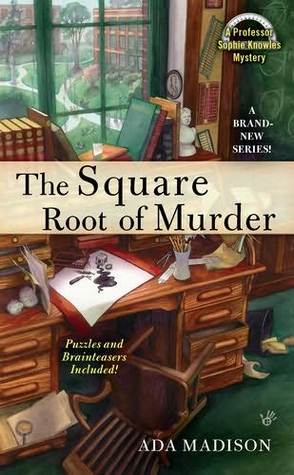A brand new series with my favorite kind of heroine - a brainy one! Ada Madison debuts a new mystery series, although the author has been a popular mystery author under different names (aka Margaret Grace and Camille Minichino.)
Author: Ada Madison
Copyright: July 2011 (Berkly) 304 pgs
Series: 1st in Professor Sophie Knowles Mysteries
Sensuality: n/a
Mystery Sub-genre: cozy
Main Character: Math Professor Sophie Knowles who creates puzzles for publication in her spare time
Setting: Modern day, Henley Massachusetts
Obtained Through: Publisher for an honest review.
Dr. Keith Appleton, a fellow professor, is widely disliked. He is caustic, contentious, and mean spirited. So it doesn't surprise Sophie when her assistant Rachel shares that Dr. Appleton is being difficult about her thesis for him. When Dr. Appleton is found poisoned and the pages of Rachel's thesis are scattered around him it appears she killed him. Sophie can't help herself as she starts looking into the case on her own. What she finds surprises her in many ways. Who knew Dr. Appleton had a soft side?
Sophie is a character I liked quickly. She is smart in math but a little sheltered. She actually concerns herself with caring about people and feels guilty that she felt Dr. Appleton was an ogre. The story is in first person which isn't my favorite but this one was okay for me. I liked how her best friend is more a free spirit and not as analytical but their relationship works. Sophie's boyfriend Bruce seems like a good guy (Medevac helicopter pilot who is a movie buff) who isn't harping about her investigating - a plus in my book.
The plot is good, not overly complicated but there are plenty of suspects and Sophie approaches it logically. The climax had some tense moments as the killer confronts Sophie. The wrap up was good. I especially enjoyed the interaction with the Dean (who often censured Sophie) towards the end. I liked that it is an easy read, inspite of the math, with just enough mystery. Out of the gate it was a little slow as the reader is introduced to Sophie and the basic situation, but I thought it picked up once the murder occurred.
I must be a geek myself because I enjoy brainy characters like this. I enjoyed the Periodic Table Mysteries and was disheartened when that series came to a halt. I also enjoy mysteries around academic settings with the micro world of campus life. This story brings the campus politics and professor-student as well as professor-professor relationships into the spotlight. If you enjoy your heroine smart and not-too-complicated consider this mystery.
Now for some geek humor - this is considered a classic.


























